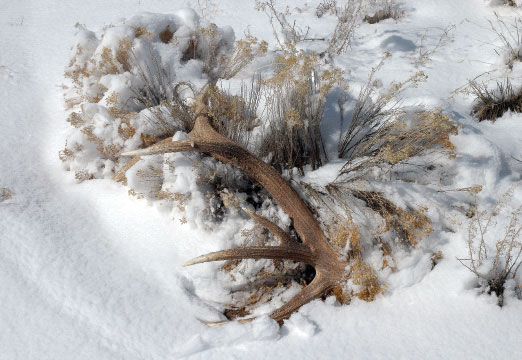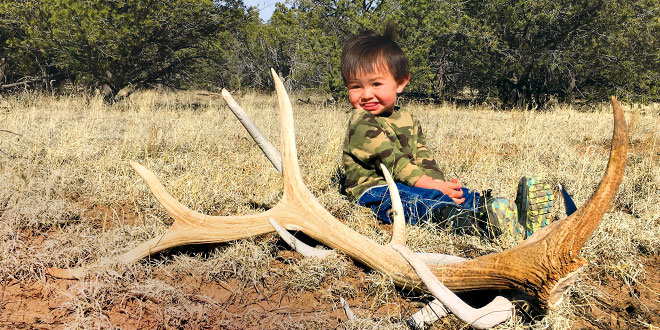Spring is here, it’s time to hunt sheds
Spring is a time many hunters put their gear away and begin the painstaking wait for autumn and the arrival of the 2017 hunting season.
But hunting season is far from over.
For those suffering from cabin fever and ready to enjoy a family-friendly opportunity, lace up a pair of hiking boots and head out in search of shed antlers.
The time is right for people to load up and explore the mountains for sheds. Not only can it be great exercise, but those hoping to be drawn in 2017 also can start to look at areas they hope to hunt.
Elk bulls and buck deer will drop their antlers between February and May, providing a good window of opportunity to spend time outdoors hunting for the elusive sheds.
Where to go?
Those heading out need to look in areas where bull elk and buck deer have wintered. Fields and edges along fields are good locations. Walking fence lines where animals jump are great spots because the jarring of jumping can cause loose antlers to fall off.
Equipment
For those planning to spend time in the mountains, it is prudent to pack survival and shed hunting equipment.
Bringing a pack frame for hauling out antlers is a good idea because it will take some leg work. A spotting scope and good set of binoculars will aid in glassing far ridges for antlers lying on hillsides and ridges.
Shed hunting will likely mean navigating a good deal of uneven, rocky terrain, making such a trip a great time to break in a new pair of boots obtained for Christmas.
GPS units provide useful information on areas that were already explored to maximize coverage in the field.
Be prepared
When heading to the mountains it is important to be prepared. It can still be quite cool at higher elevations, especially after sunset, so it’s important to dress appropriately and have survival equipment, including fire starting material, navigational tools, plenty of food and water, needed medication and a first aid kit.
Providing a location and return date to family and friends is always wise. Consider servicing your vehicle beforehand and have shovels, axes, winches and spare tires. Take the extra steps to protect yourself and your family.
Temperatures will also dictate when rattlesnakes will become active, so be alert and always know where you are placing your hands and feet.
What to do with shed antlers?
After finding some antlers, some of which can be quite large, the next step is deciding what to do with the prize.
Many possibilities exist, including using them to decorate a home or yard.
Some may use the antlers to make home furnishings, for artwork or to create knife handles. The uses are limited only by a person’s imagination; deer antlers can be used as wine or coat racks.
Others may prefer to sell sheds to antler buyers. Payment is usually by the pound and they may, in turn, be sold to private collectors, made into dog chews or utilized for medicinal purposes.
Those who sell antlers from animals harvested or legally picked up in the field with skull plates need to pass along the paperwork with receipt numbers and hunting license numbers.
Rules
Shed hunting should be a fun and challenging experience, so before heading out, know the laws.
Currently, a license or permit is not required to collect shed antlers in New Mexico. However, permission is required from private landowners. Vehicles need to remain on designated roads and trails and be sure off-highway vehicles are in compliance with registration and safety equipment.
Tribal lands have their own rules and regulations, so it is important to check with the appropriate tribal game and fish before venturing out.
Antlers still affixed to a skull or piece of skull, whether found on public or private land, cannot be picked up. These are the property of the state and picking them up is illegal.
If antlers affixed to a skull plate are found, take a picture in the field, note GPS coordinates and contact the local Game and Fish conservation officer to obtain permission to bring them out.
The antlers will need to be purchased, but upon doing so a possession permit will be issued and the revenue collected supports the Game Protection Fund. Unused carcass tags or a hunting license cannot be used to bring heads out from the field.
Documentation is also required for an individual to legally transport a skull from another state or on tribal lands into New Mexico or across tribal boundaries. Contact a local conservation officer in the state or jurisdiction to obtain documentation stating the head came from their state or tribal lands.
Skulls of other protected animals, such as oryx, pronghorn antelope, barbary sheep, cougar, javelina or bears are also illegal to pick up in the field. A person must get permission to remove these from the field from the local Game and Fish conservation officer.
When permission is granted to retrieve the skull, it then needs to be purchased from the department and a receipt will be issued.
Report any bighorn sheep skulls and department staff will obtain these from the field. Bighorn skulls will be tagged and auctioned.
Pronghorn antelope horn sheaths, which are shed annually and are an exception to other horned animals, may be collected.
Spring is here, so head to the woods for some fun in search of shed antlers.

Prime shed-hunting areas
Shed hunting locations will change from season to season because the travel patterns of elk and deer will vary. The Lincoln and Santa Fe National Forests hold good elk populations along with the Magdalena and Mount Taylor ranger districts in the Cibola National Forest. For those new to the activity, the Valle Vidal and Apache Creek are good places to start.
Valle Vidal – Carson National Forest
There are many great spots to hike, camp and ride horseback in this beautiful area of the Carson National Forest. It is located five miles northwest of Cimarron and northeast of Questa.
The Valle Vidal has some specific dates when people can visit. The east side from Highway 64 to the Clayton Corrals is open from April 1 to Dec. 31. The west side from Costilla to Clayton Corrals is open from July 1 to April 30.
Typically, elk will start dropping their antlers in mid-March.
To have a great chance at finding shed antlers, traveling east from Cimarron, turn off N.M. 64 onto Forest Road 1950. The next 22 miles is private property owned by Vermejo Park Ranch. Beyond that shed hunters have plenty of opportunities to hike or ride.
Apache Creek – Gila National Forest
The Gila National Forest is large and one of the best places in New Mexico to look for shed antlers. Head into Reserve and drive north on N.M. 12 about 12 miles until reaching the Apache Creek Campground.
Places to look for sheds here are endless. Drive down Forest Road 94 and start looking for sheds anywhere or drive to John Kerr Peak or Eagle Peak. A GPS is recommended because it is easy to get lost. Looking on the east and north side slopes of mountains is always a great start.
 New Mexico Wildlife magazine Conserving New Mexico's Wildlife for Future Generations
New Mexico Wildlife magazine Conserving New Mexico's Wildlife for Future Generations
